Cost of Development: How Refinery, Highway Project are Vanishing Akwa Ibom’s Stubbs Creek Forest
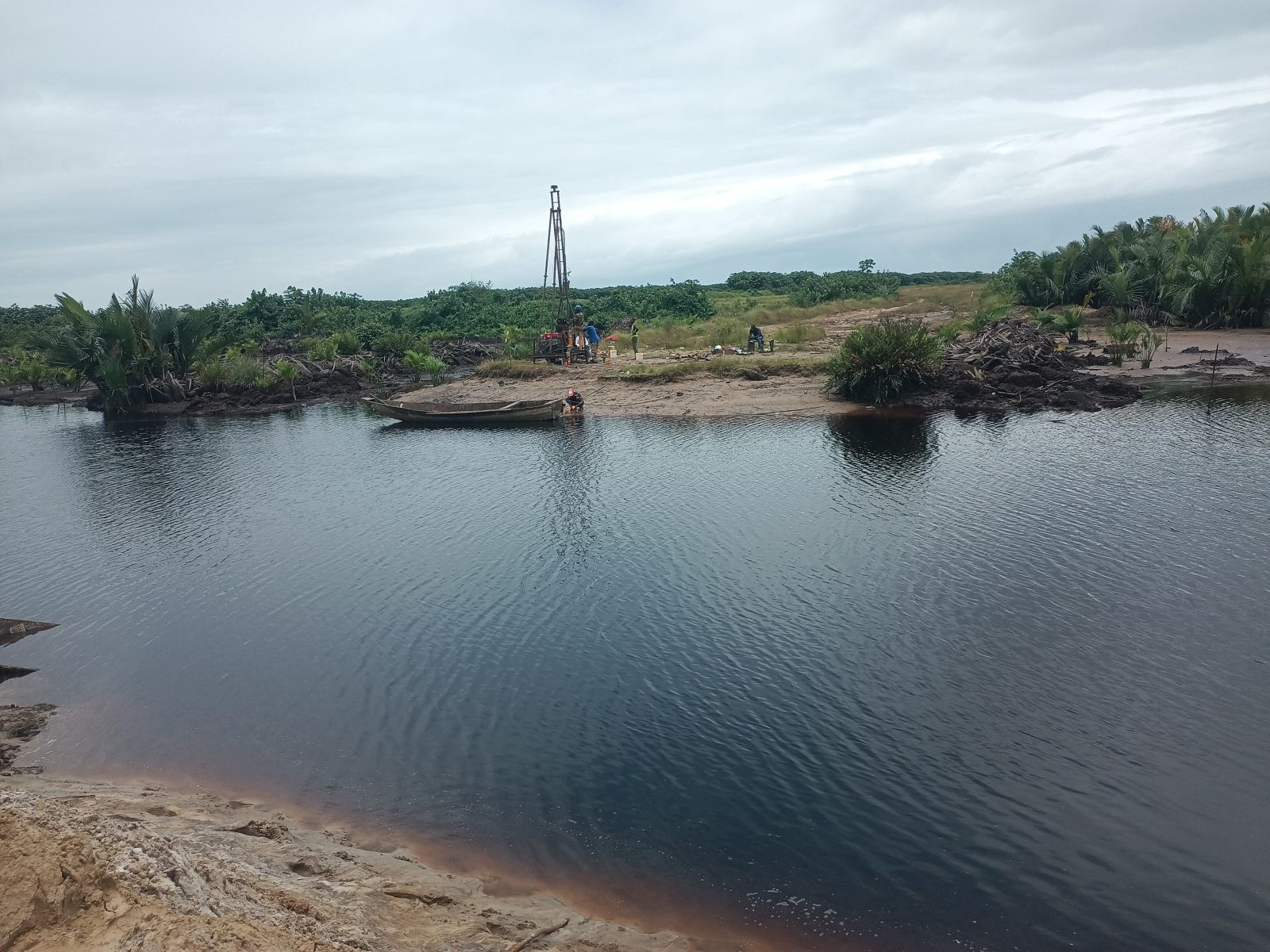
By Ekemini Simon
Sarah Victor, a mother of five, once depended on the rich resources of the Stubbs Creek Forest Reserve in Akwa Ibom State for her livelihood. The forest supplied the herbs she used to treat ailments such as stroke, hypertension, arthritis, diabetes, and epilepsy, her main source of income and healing practice.
Years ago, the reserve, spanning Esit Eket, Ibeno, and Mbo Local Government Areas, was a thriving biodiversity hotspot. Covering about 310.8 square kilometres, it was one of southern Nigeria’s richest ecosystems, home to valuable tree species such as African mahogany, African satinwood, Afara, and African walnut. It also provided critical habitat for endangered primates, including Sclater’s guenon, Mona monkey, Putty-nosed monkey, and the red-capped mangabey.
Today, much of that forest is gone. In 2017, it was first cleared for a now-abandoned 55-kilometre superhighway initiated by the Akwa Ibom State Government to link a proposed seaport in Mbo Local Government Area in Akwa Ibom State. Three years later, more forest land was lost to the yet-to-be-completed 200,000-barrel-per-day BUA petrochemical refinery.
Stubbs Creek Forest Reserve has become a case study in how poorly managed development and corporations’ disregard for environmental and social sustainability can destroy both biodiversity and livelihoods.
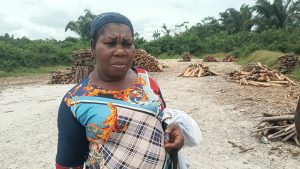
I used to find those rare herbs only within Stubbs Creek, around the area now cleared for the refinery,” Mrs. Sarah said. “Since I can’t find them anymore, I no longer treat people. They now go to hospitals where treatment costs more than they can afford.”
Apart from herbal practice, Mrs. Sarah also trades in gin made from palm wine, bitter kola, and African oil bean seeds collected from the forest. But with most of the trees that provided these materials now gone, her source of income has collapsed.
“Even the dry gin made from palm wine, I no longer get in good quantities because large numbers of raffia palms whose wine is used to produce the gin have been destroyed by the refinery project,” she said, adding that her husband had been jobless for a long time. As a result, Mrs. Sarah said feeding her family and catering for the academic needs of her children has been difficult.
“It is very unfair that those who have a better and more sustainable livelihood are now using their business to destroy the little that we depend on,” she added.
Livelihood pressure and further destruction of the forest
Like Mrs. Sarah, Okon Itiaba, a father of four, once earned his living tapping palm wine and fishing in the wetlands of the Stubbs Creek Forest Reserve. But after large parts of the forest were cleared by the Akwa Ibom State Government and BUA Refinery Limited, his livelihood became much harder to sustain. He now treks deep into the remaining forest to find raffia palms, spending long hours that reduce both the quality and market value of his product.
“Palm wine sells better when it’s fresh,” said Mr. Itiaba. “Now, before I can bring out the palm wine from the deep forest out to where people can access and buy, it will ferment, and the price drops,” he said.

He described how the rough terrain and distance often cost him his day’s work.
“Due to the topography and long distance of the deeper forest, which makes me climb and slope on hills, pass through muddy grounds, swim through the creeks, and sometimes get pierced by branches, the gallon of wine sometimes falls off pouring and leaving me to return home empty-handed,” Mr Itiaba said.
Mr Itiaba, also a fisherman, another mainstay for many in Niger Delta communities, said before the BUA project, the wetlands were pristine and vast for fishing. But now, most of those wetlands have been sand-filled, making catches rare.
From his palm wine business, he recalled how he used to make sales up to N15,000 daily, but now can hardly make N2,000 sales each day. “Now, my family feeds once a day,” he said. “Due to the situation now, there are only two of my last children that I can send to school. The two older ones have dropped out of school to assist me in my palm wine tapping business; otherwise, we won’t be able to survive.”
With the forest – and his livelihood – disturbed by the highway and refinery projects, Mr Itiaba said he is now considering wood logging, an activity he knows will harm the reserve but may be his only option.

He is not alone. Ubong Thompson, who, before the BUA project, used to hunt wild pigs, deer, grasscutter, and guinea fowl as a protein source for his family and also sells some, has also turned to cutting down trees for firewood sales. “I never used to cut trees, but I can’t sit helplessly and see my family hungry. That’s why I am venturing into this firewood business,” Mr Thompson said.

When TheMail Newspaper visited the forest in September, the section cleared for the superhighway project remained bare, though shrubs had begun to grow along the corridor since the project was abandoned a year after it began.
A new access road built for BUA’s refinery now cuts six kilometres into the forest, exposing even more of the reserve to deforestation. Along the route, a thriving logging market has emerged, with wood of various sizes stacked for sale and trucks, tricycles, and motorcycles ferrying logs out of the forest.
Sellers told TheMail that the timber is used primarily for building and firewood and that logging has continued unchecked since 2021, when the BUA access road construction began.
Yet, the socio-environmental consequences of the projects- biodiversity loss, habitat fragmentation, and livelihood collapse – had long been predicted.
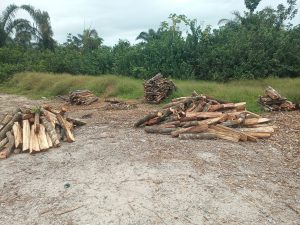
Warning ignored
In 2016, the Federal Government conducted an Environmental and Social Impact Assessment (ESIA) for the BUA refinery project.
The ESIA report predicted “loss of wetlands (breeding/spawning grounds), depletion of natural resources (water, sand, wood), ecosystem and habitat loss or fragmentation and introduction of invasive species.” It also warned that project activities could lead to “increased access to wildlife leading to exploitation, and de-vegetation and clearing, soil stripping, removal of cleared vegetation (burning, leveling), earthworks (sand filling), and damage to soil structure, causing change in natural drainage channels and soil porosity during soil stripping process, thus top soil may mix with less fertile subsoil and loss of capacity to retain moisture.”
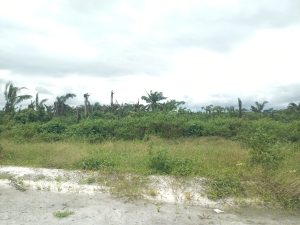
Some of the destroyed raffia palm
The ESIA further highlighted that such environmental degradation would cause negative impacts on livelihoods and the microeconomy of communities that depend on the Stubbs Creek Forest Reserve.
In response, BUA pledged to mitigate the envisaged damage by involving government agencies and conservation specialists in ecological restoration and by raising awareness among staff and community members. It is also committed to installing siltation traps to protect soil and water, cultivating compacted areas, creating drainage systems to reduce flooding, and compensating economically displaced residents through a livelihood restoration plan.

Other pledges by BUA included the creation of seed banks before vegetation is damaged for replanting, exposure of workers and locals to conservation programmes that will seek to protect endemic/endangered species, and the establishment of conservation programmes that will seek to protect endangered and endemic species.
BUA fails to honour pledges?
It remains unclear whether BUA has fulfilled the commitments outlined in its environmental plan. When TheMail sent a media inquiry to the company’s official email on October 3, 2025, there was no response. Multiple calls and messages to the Communications, Documentation, and Data Officer, Abdul-Azeez Isiaq, also went unanswered despite several follow-ups over consecutive days.
During a field visit, TheMail found no visible evidence of replanting, siltation traps, or drainage systems at the project site. Residents said they have not received any compensation or training as promised. Community members from the host areas also confirmed that no one has been compensated for economic displacement and denied taking part in any workshop or seminar on biodiversity conservation.
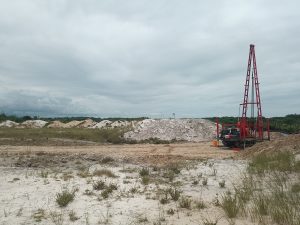
Akwa Ibom Government’s weak environmental governance and breaches
In 2000, Akwa Ibom State enacted “A Law for the Preservation and Control of Forests in Akwa Ibom State”, granting Stubbs Creek Forest Reserve protected status. Section 21 of the law outlines a clear and rigorous process that must be followed before any part of a forest can be de-reserved.
Although the law empowers the state’s Commissioner for Agriculture to de-protect a site or part of it, there is no evidence that the process has been followed according to the prescribed process before Stubbs Creek reserve was severely violated by corporate and political activities.
A Freedom of Information (FOI) request on October 3, to the Ministry of Agriculture, asking for the gazetted notice to de-reserve the sections of Stubbs Creek forest used for the superhighway project and BUA Petrochemical and Refinery Project, was not responded to despite acknowledgement.
Similarly, a review of the Akwa Ibom State House of Assembly Hansards from 2016 to 2021 revealed no record of any legislative proceedings to de-reserve the forest.
Unlike BUA, which at least conducted an Environmental and Social Impact Assessment (ESIA) for its refinery project, the Akwa Ibom State Government failed to comply with the Environmental Impact Assessment (EIA) Act of 1992 regarding its superhighway project. The federal law mandates that an EIA must be carried out for any project likely to significantly affect the environment.
An FOI request for the EIA report was also sent on October 3, 2025, to the Commissioner for Works, Professor Eno Ibanga, whose ministry supervised the superhighway project. The ministry acknowledged receipt but never responded.
When TheMail contacted the Federal Ministry of Environment, statutorily empowered to conduct the ESIA, the Akwa Ibom State Controller, Mr Patrick Etim, told TheMail that the ESIA for the project was never conducted, hence does not exist.
Between 2016 and 2025, the state government budgeted N76 million under its Forest Regeneration Plan for the planting of Gmelina aborea, pine, and nuclear diderichi trees in Stubbs Creek. However, a review of financial statements and budget performance reports showed that no funds were released or spent. The Ministry of Environment also failed to respond to requests for evidence of project implementation.
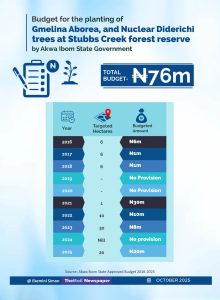
In addition, our newspaper’s analysis of the 2023 and 2024 budget performance reports revealed that N18.2 million was paid as “commuted allowance” for forest guards. But residents and firewood traders interviewed said they had never seen guards patrolling the Stubbs Creek.
The Akwa Ibom State Government has repeatedly declared its commitment to the Sustainable Development Goals (SDGs), particularly the goal to protect and restore terrestrial ecosystems, halt deforestation, and conserve biodiversity. But its actions at Stubbs Creek tell a different story.
The Ministry of Environment has also remained silent on the issue. Commissioner for Environment and Mineral Resources, Mr Nsikak Ekong, initially told TheMail he would respond after internal consultations, but later became unreachable. When contacted again on October 13, he requested that questions be sent via text message and promised a response, which never came as of press time.
TheMail had sought explanations regarding the unimplemented reforestation plan, continued illegal logging, the absence of forest guard oversight, and the state’s efforts to ensure BUA fulfils its mitigation commitments. The government has yet to provide any answers.
For people like Mrs. Sarah, Mr. Itiaba, and Mr. Thompson, the loss is personal and generational. The forest that once healed, fed, and sustained their families is vanishing before their eyes.
This story was produced as part of Dataphyte Foundation’s Biodiversity Media Initiative project, with support from Internews’ Earth Journalism Network.

